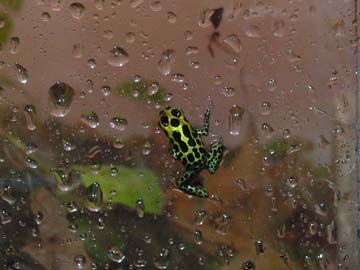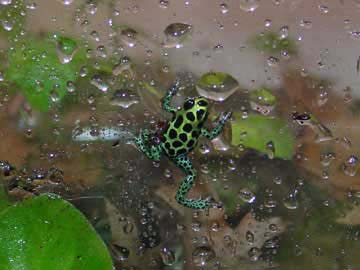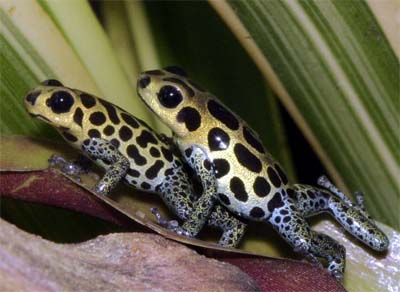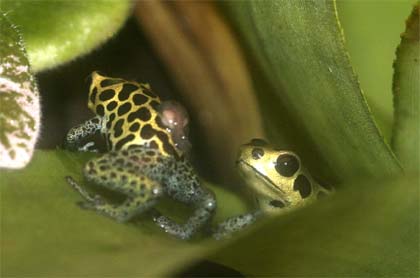  |
Dendrobates imitator is a good beginner thumbnail frog. In the wild, D. imitator inhabit areas of Peru. They are becoming more and more common in the hobby; for many people this is their first thumbnail species. These frogs climb a lot and will take advantage of vertical space. We keep the frogs in vertical 2.5 gallon tanks until they almost reach maturity. These enclosures are heavily planted and the substrate is our mix of soil and leaf litter. We seed the soil heavily with springtails and place a small piece of banana in the enclosure for the springtails to eat as well as food for any excess fruit flies. This gives the frogs security and frees them from the stress of the flies walking on them, yet concentrates the food so that they easily find it and can grow quickly. These frogs are pretty bold and usually easily observed in the enclosures. We make sure that there are no spaces in the enclosure for them to squeeze through. Keep in mind that these are a small frog that is fully grown at about 1/2 inch and can squeeze through the tiniest cracks. They spend a lot of time in the higher sections of the enclosure and in bromeliads, but will use most of the space in the enclosure. Imitators are fairly aggressive feeders, although individuals should be monitored. At the first signs of bullying the frogs should be seperated. Once the frog matures we move it to a vertical 15 gallon enclosure. There is little sexual dimorphism in D. imitator and the main indicator is body type. Pictured above on the left is a male. His body is more rectangular, meaning that the width of his body at the hips is the same as it is at the shoulders. Next to him on the right is a female. Her body shape is triangular or "pear" shaped meaning that the body is wider at the hips than the shoulders.The female is also a more robust frog. Pictured below on the right are a male and female, the female is the larger of the 2 frogs. The males can start calling at as young as 4 months and mature soon after. The call is a light buzzing sound that can be heard when you are near the enclosure. D. imitator may be kept communally, as long as there is enough room for each animal to set up a territory, The more plants (especially bromiliads) that you have in an enclosure , there less likely it is that you will have territorial disputes. Males may fight, but sometimes so will females. As with all other dart frogs, monitor them daily and look for signs of agression. If excessive aggression is observed the animals should be seperated. We used to house 2:2 in a medium/large enclosure and have noted the larger more dominant female destroying the eggs of the subordinate female if they are laid too closly to her own. If you are inclined, you can take notes on the pattern of all your animals to keep a record of the sex of the individuals. In heavily planted vivaria, the male will call the female to him and continue to call her into the breeding location. This is where mating takes place.
|
D. imitators lay clutches of 2 to 5 eggs but a healthy pair can lay eggs every two or three weeks. The eggs are usually laid in an upside down film canister, on a verticle leaf or in a bromiliad. We leave the eggs in the enclosure for at least 24 hours after finding them to make sure that they are fertilized. The hatch rate for imitator eggs is usually high. We also believe that high humidity and a very wet enclosure are a key to getting the imitators to breed. We sometimes let the parents rear the tads. The parents will feed the tads with unfertilized eggs, but this this is not the only way that the tads can be raised (unlike true egg feeders) so the eggs can be removed and raise d individually in glass mason jars or in nested rubbermaid containers that have dividers and a screen bottom on the inside container. It is just really fun to see the parents raise the tads to froglets. This does however slow down egg production because fertile eggs will not be produced the whole time the tads are being raised. The tads morph out fairly large and are fed springtails and Drosophila melanogaster that are dusted daily with Repcal. We also dust several times a week with Herptivite. We follow this dusting regime with our adult frogs too. The frogs reach maturity in 5-7 months.
|
 |
 |
We have noted that D. imitator like a well planted vivarium and prefer to lay eggs in an upside down film canister or pill bottle, in bromiliads or on the glass of the enclosure. We attach the pill bottle to the side of the enclosure with small suction cups that can be purchased in most hardware stores. At this time all of our eggs have been laid in bromiliads and we sometimes let the parents rear them. The picture at the left shows a male carrying a tad and the female behind him. We keep the humidity very high and do not let the temperature rise above 83°.
Summation:
Size- 14 - 16 mm, visual differences between sexes are apparent, females are larger and rounder, males have a quiet buzzing call
Care- Imitators are relatively easy to care for and a good beginner thumbnail species. They are quite bold, although individuals may be shy
Food- springtails and D. melanogaster you can try hydei but, they may be too large
Eggs and Tads- clutches of 2 to 4 eggs, tads are omnivorous and should be raised singly
Temperature- 70°-80°
Locality - Peru
|
|
|

